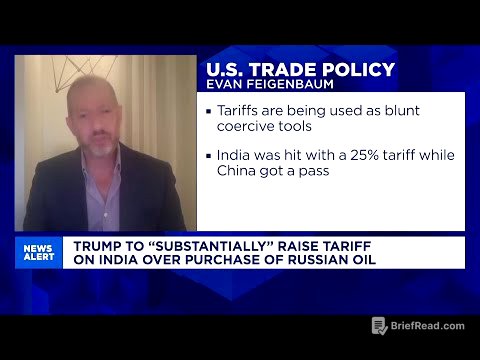TLDR;
This video discusses the rise of Chinese AI models, particularly the Kuan series from Alibaba Group, and their impact on the global AI landscape. It highlights the open-source nature of these models, their impressive performance compared to models like Kimi K2 and Claude 4, and the potential implications for AI development and technological sovereignty. The video emphasizes the need for other countries, including Korea, to strategically develop their own AI capabilities in specialized areas to avoid over-reliance on foreign technologies.
- Kuan 3, an open-source model from Alibaba, outperforms Kimi K2 and rivals Claude 4 in certain benchmarks.
- China's open-source AI strategy, backed by significant government funding, is rapidly changing the AI market.
- The video stresses the importance of technological sovereignty and strategic AI development in other countries to avoid dependence on foreign AI technologies.
Introduction [0:00]
The video introduces the topic of Chinese AI, specifically focusing on the Kuan series from Alibaba Group. The speaker acknowledges potential negative reactions to Chinese content but emphasizes the importance of objectively assessing China's technological advancements to stay informed about global tech trends. The discussion aims to compare the strategies of Chinese and American tech companies in the AI sector and to highlight the increasing influence of open-source AI models from China.
Kimi K2 and the Rise of Kuan 3 [0:07]
The speaker discusses Kimi K2, an open-source AI model with one parameter, and introduces Kuan 3, an updated version of Alibaba's Kuan series. Kuan 3 version 257 has less than one parameter but outperforms Kimi K2. The Kuan series is widely used in China, especially by developer groups building various services.
Alibaba's Kuan AI Research [2:33]
Alibaba Group has been researching the Kuan AI model for about 10 years, with the first release, Tongyiqian N1, in April of the year before last. The ecosystem around Kuan began to grow in August with the open-sourcing of 7 billion parameter models. The Kuan family includes basic models like 1.5, 2, 2.5, and 3, as well as specialized versions for mass use, vision, and coding.
Kuan 3 Model Details and MOE Structure [3:43]
The Kuan 3 family ranges from 0.6 billion to 235 billion parameters, with models distilled for on-board AR and local use. The larger models use a Mixture of Experts (MOE) structure, where only a portion of the model is activated during use, reducing GPU utilization. For example, the 235 billion parameter model only activates 22 billion parameters during output generation. This approach balances overall knowledge capacity with practical efficiency.
Context Length and Thinking Models [5:16]
The context length, or the amount of text that can be processed at once, is discussed. Meta's Llama initially had a context length of 131K, which was later updated to 256K. The speaker also touches on "thinking models," or reasoning models, like OpenAI's GPT-4.5, which are designed for inference and complex reasoning tasks.
Performance Benchmarks and Comparisons [6:47]
Kuan 3 2507 outperforms Kimi K2 and Claude Opus 4 in AI 25 benchmark. Kuan 3 2507 has been updated with more precise long context processing capabilities, leading to higher scores in complex benchmarks. The speaker notes that Alibaba's research history is extensive, and Kuan is widely used.
Korean Language Performance and Model Rankings [8:35]
Korean language performance across various models is assessed, with Perplexity Sonar Pro currently evaluated as the best for Korean. Kuan 3 235 Billion 2507 performs better than Deep V3024. Among Korean models, SKT's AX4.0 is considered quite good. Upstage and Kuan 3 are at almost the same level.
Open Source and Technological Sovereignty [10:15]
The speaker emphasizes that good performance can be achieved even with smaller parameter counts through fine-tuning and continuous learning. The open-source nature of models like Kuan has a significant impact on AI services. China's heavy investment in AI and open source, supported by government funding, is creating a competitive landscape. The speaker raises concerns about potential dependence on Chinese open-source AI and stresses the importance of technological sovereignty.
Strategies for Other Countries [12:53]
Given the difficulty in matching China's capital investment, other countries should focus on developing AI models in specialized areas like medicine, law, and semiconductors. Securing quality Korean language data by industry is crucial. The goal is to create AI models suitable for the local environment that can be well-established.
AI as a Tool and National Security [13:50]
The emergence of AIs like Kuan 3 and Kimi K2 signifies that AI is becoming a tool that can enter key industries and protect national security. The speaker warns of the risk of becoming overly dependent on open-source AI and emphasizes the need to think about how to respond and secure technological sovereignty.









